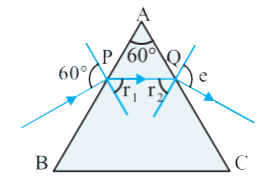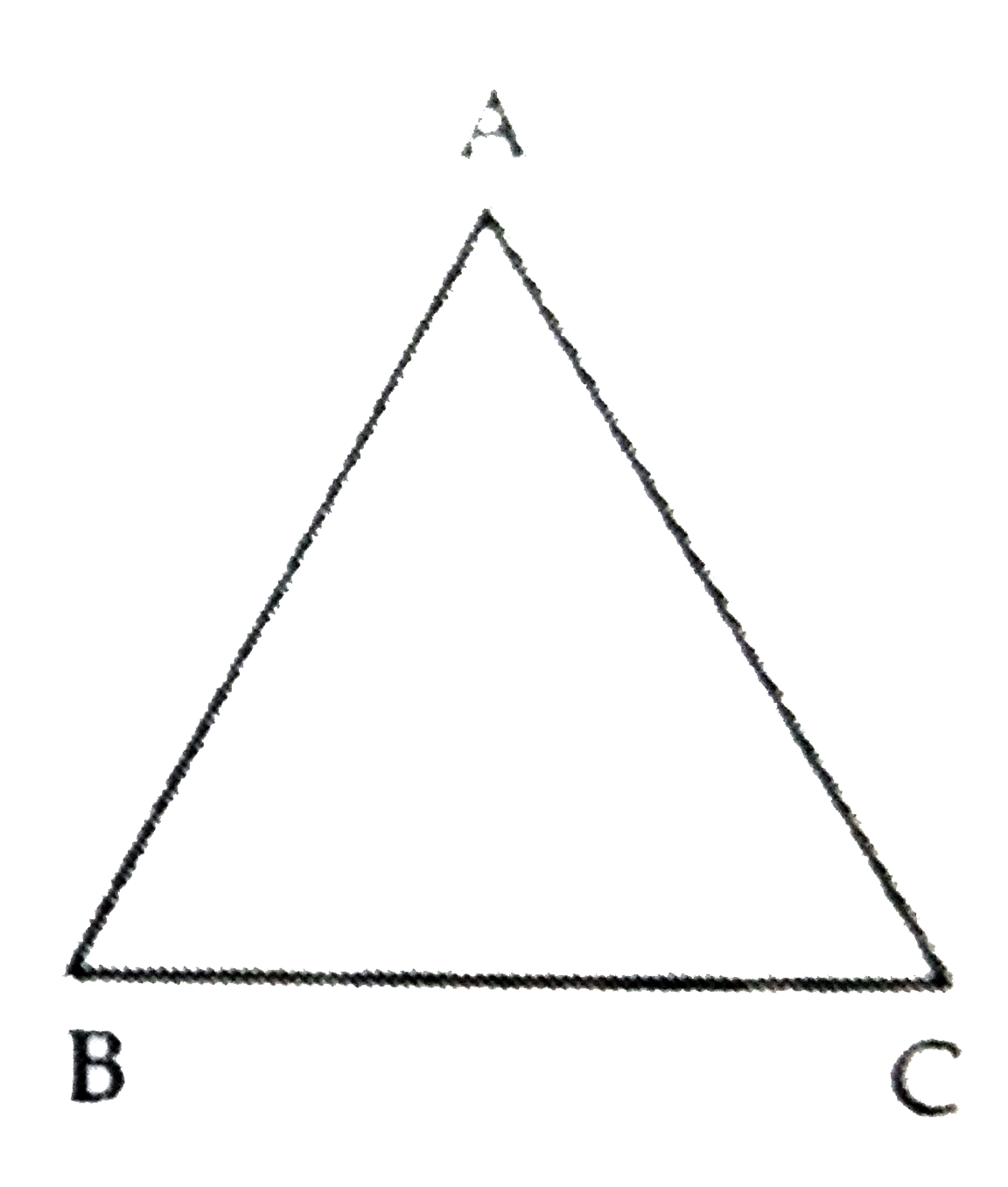A ray of light incident on an equilateral triangular glass prism of μ=√3 moves parallel to the base of the prism inside it. What is the angle of incidence for this ray ?
To solve the problem, we need to find the angle of incidence for a ray of light striking an equilateral triangular prism with a refractive index (μ) of √3, such that the ray moves parallel to the base of the prism inside it.
1. Understand the Geometry of the Prism:
- An equilateral triangle has all angles equal to 60 degrees. Therefore, each angle of the prism is 60 degrees.
2. Identify the Incident Ray and Refraction:
- Let the incident ray strike the prism at point A and make an angle of incidence i with the normal at that point.
- After refraction, the ray inside the prism is parallel to the base BC of the triangle.
3. Determine the Angle of Refraction:
- Since the ray inside the prism is parallel to the base BC, the angle of refraction r at point A must be 30 degrees. This is because the angle at the base (60 degrees) minus the angle of refraction (30 degrees) gives us the angle with the normal (90 degrees).
4. Apply Snell's Law:
- According to Snell's law:
n1sin(i)=n2sin(r)
- Here, n1 (the refractive index of air) is 1, n2 (the refractive index of the prism) is √3, and r=30∘.
5. Substitute the Values into Snell's Law:
- Substitute the known values into Snell's law:
1⋅sin(i)=√3⋅sin(30∘)
- Since sin(30∘)=12, we have:
sin(i)=√3⋅12
- This simplifies to:
sin(i)=√32
6. Find the Angle of Incidence:
- The angle i for which sin(i)=√32 is:
i=60∘
Final Answer:
The angle of incidence i is 60∘.
---
- An equilateral triangle has all angles equal to 60 degrees. Therefore, each angle of the prism is 60 degrees.
- Let the incident ray strike the prism at point A and make an angle of incidence i with the normal at that point.
- After refraction, the ray inside the prism is parallel to the base BC of the triangle.
- Since the ray inside the prism is parallel to the base BC, the angle of refraction r at point A must be 30 degrees. This is because the angle at the base (60 degrees) minus the angle of refraction (30 degrees) gives us the angle with the normal (90 degrees).
- According to Snell's law:
n1sin(i)=n2sin(r)
- Here, n1 (the refractive index of air) is 1, n2 (the refractive index of the prism) is √3, and r=30∘.
- Substitute the known values into Snell's law:
1⋅sin(i)=√3⋅sin(30∘)
- Since sin(30∘)=12, we have:
sin(i)=√3⋅12
- This simplifies to:
sin(i)=√32
- The angle i for which sin(i)=√32 is:
i=60∘
The angle of incidence i is 60∘.
Similar Questions
A ray of light is incident on one face of a prism (m=√3) at an angle of 60∘. The refracting angle of the prism is also 60∘. Find the angle of emergence .

View SolutionWhat is the angle of incidence for an equilateral prism of refractive index √3 so that the ray si parallel to the base inside the prism?
View SolutionA ray of light passing through an equilateral triangular glass prism from air undergoes minimum deviation when angle of incidence is 3/4 th of the angle of prism. Calculate the speed of light in the prism.
View SolutionA ray of light passing through an equilateral triangular glass prism from air undergoes minimum deviation when angle of incidence is 34th of the angle of prism. Calculate speed of light in prism.
View SolutionA ray of light is incident on the hypotenuse of a right-angled prism after travelling parallel to the base inside the prism. If μ is the refractive index of the material of the prism, the maximum value of the base angle for which light is totally reflected from the hypotenuse is
View SolutionA monochromatic light is incident at a certain angle on an equilateral triamgular prism and suffers minimum deviation . If the refractive index of the material of the prism is √3, them the angle of incidence is :
View SolutionAnswer the following:
(i) A ray of light incident on face AB of an equilateral glass prism, shows minimum deviation of 30∘. Calculate the speed of the light through the prism.
(ii) Find the angle of incidence at face AB so that the emergent ray grazes along the face AC.

View SolutionA ray of light is normally incident on one face of an equilateral glass prism. Answer the following :
(a) What is the angle of incidence on the first face of the prism?
(b) What is the angle of refraction from the first face of the prism ?
(c) What will be the angle of incidence at the second face of the prism ?
(d) Will the light ray suffer minimum deviation by the prism ?
View SolutionA ray of light is incident on a transparent glass slab of refractive index √3. If the reflected and refracted rays are mutually perpendicular, what is the angle of incidence?

View SolutionA ray of light passes through an equilateral glass prism in such a manner that the angle of incidence is equal to the angle of emergence and each of these angles is equal to 3/4 of the angle of the prism. The angle of deviation is
View Solution
